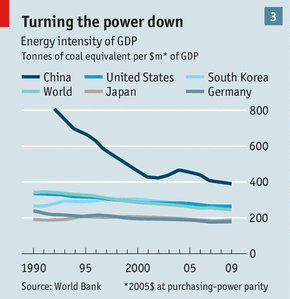ALL industrial nations one day hit an environmental turning-point, an event that dramatises to the population the ecological consequences of growth. In America that event occurred in 1969 when the Cuyahoga river in Ohio, thick with pollutants and bereft of fish, caught fire. America’s Environmental Protection Agency was founded the next year. Strict environmental laws passed by Japan in the 1970s followed the realisation that poisonous mercury spilled from a plastics factory was claiming thousands of lives around the bay of Minamata.
The fetid smog that settled on Beijing in January 2013 could join the ranks of these game-changing environmental disruptions. For several weeks the air was worse than in an airport smoking lounge. A swathe of warm air in the atmosphere settled over the Chinese capital like a duvet and trapped beneath it pollution from the region’s 200 coal-fired power plants and 5m cars. The concentration of particles with a diameter of 2.5 microns or less, hit 900 parts per million—40 times the level the World Health Organisation deems safe. You could smell, taste and choke on it.
Public concern exploded. China’s hyperactive microblogs logged 2.5m posts on “smog” in January alone. The dean of a business school said thousands of Chinese and expatriate businessmen were packing their bags because of the pollution. Beijing is one of China’s richest cities. Before the 2008 Olympic games it had relocated its smelliest industries to surrounding provinces. If anywhere should be cleaning itself up, it is the capital. Yet even Communist bigwigs, opening their curtains each morning near the Forbidden City, could not avoid the toxic fog.
Journey to the West
The “airpocalypse” injected a new urgency into local debate about the environment—and produced a green-policy frenzy a few months later. In three weeks from the middle of June, the government unveiled a series of reforms to restrict air pollution. It started the country’s first carbon market, made prosecuting environmental crimes easier and made local officials more accountable for air-quality problems in their areas. It also said China—meaning companies as well as government—would spend $275 billion over the next five years cleaning up the air. Even by Chinese standards that is serious money, equivalent to Hong Kong’s GDP or twice the size of the annual defence budget.
Is this China’s turning-point? Many environmentalists, both in the country and outside, fear it is too little, too late. A study released by America’s National Academy of Sciences in July found that air pollution in the north of China reduces life expectancy by five-and-a-half years. The rivers are filthy, the soil contaminated. The government has long known this and attempted to clean things up. Yet still the smog comes.
And there is something else in the air, less immediately damaging but with a far bigger global impact. China’s greenhouse-gas emissions were about 10% of the world’s total in 1990. Now they are nearer 30%. Since 2000 China alone has accounted for two-thirds of the global growth in carbon-dioxide emissions. This will be very hard to reverse. While America and Europe are cutting their emissions by 60m tonnes a year combined, China is increasing its own by over 500m tonnes. This makes it a unique global threat.
Nonsense, say Chinese officials. China is not responsible for the build-up of greenhouse gases. The West is. There are environmental problems, true, but China is simply following a pattern set by Britain, America and Japan: “grow first, clean up later”. China grew unusually fast but it is now cleaning up unusually fast, too. Its efforts to rein in pollution are undervalued; its investments in wind and solar power put others to shame; its carbon emissions will peak sooner than people expect. China will one day do for zero-carbon energy what it has already done for consumer electronics—put it within reach of everyone. It will not be a threat to the planet but the model for how to clean it up.
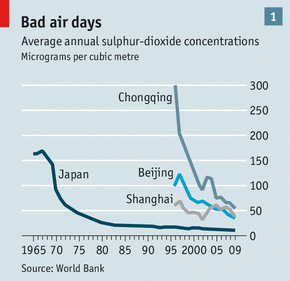
China is broadly right about one thing: its environmental problems do have historical parallels. With the exception of Chongqing, the largest municipality, most Chinese cities are no more polluted than Japan’s were in 1960 (see chart 1). Excluding spikes like that in Beijing this year, air quality is improving at about the same rate as Japan’s did in the 1970s.
Other environmental indicators are worse, however, and it is not clear whether they are improving as fast. A 2006 survey found that almost 10% of farmland was contaminated with heavy metals, such as cadmium. Whether a recent nationwide soil survey showed an improvement is hard to say, as the Ministry of Environmental Protection promptly declared the findings a state secret. The discovery of rice tainted with cadmium in Guangdong this year triggered panic buying of Thai rice.
China’s wildlife is under particular threat. The China Species Red List, an official document, classified almost 40% of the country’s mammals as “threatened” in 2004. An unusually wide range of habitats—China is exceptionally diverse in this respect—is being degraded by industrial development.
The Water Margin
The worst problem is water. Pictures of China often show green and watery landscapes. But most of northern China is as dry as straw. “Severe water stress” is usually defined as access to less than 1,000 cubic metres of water per person per year. For China the figure is just 450 cubic metres. The national average is bad enough but it hides an even more alarming regional disparity. Four-fifths of the water is in the south—mainly in the Yangzi river basin (see map). Half the people and two-thirds of the country’s farmland are in the parched north—mainly in the Yellow river basin. In Beijing there is just 100 cubic metres per person per year. The water table there has fallen by 300 metres in two decades. Wen Jiabao, a former prime minister, was barely exaggerating when he said water shortages “threaten the very survival of the Chinese nation”.
Such shortages have been a problem for centuries but they are being exacerbated now by pollution. The Yellow River Conservancy Commission, a government body, surveyed the “mother river” of China and found that for a third of its length the water was too polluted for use in agriculture. The housing ministry’s chief engineer for water safety says only half the water sources in urban areas are fit to drink.
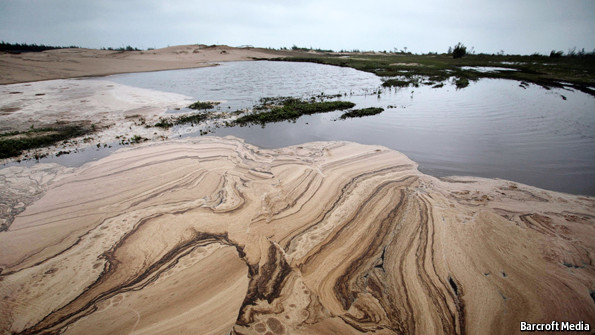 Don’t drink the water; don’t even touch the water
Don’t drink the water; don’t even touch the waterSevere though China’s problems with water, soil and air are, they are not different in kind from those of other nations in the past. As Pan Jiahua of the Chinese Academy of Social Sciences (CASS) puts it, “We’re following the US, Japan and UK and because of inertia we don’t have the capacity to stop quickly.”
China’s impact on the climate, though, is unique. Its economy is not only large but also resource-hungry. It accounts for 16% of world output but consumes between 40% and 50% of the world’s coal, copper, steel, nickel, aluminium and zinc. It also imports half the planet’s tropical logs and raises half its pigs.
The country’s energy use is similarly gargantuan. This is in part because, under Mao, the use of energy was recklessly profligate. China’s consumption of energy per unit of GDP tripled in 1950-78—an unprecedented “achievement”. In the early 1990s, at the start of its period of greatest growth, China was still using 800 tonnes of coal equivalent (tce, a unit of energy) to produce $1m of output, far more than other developing countries. Energy efficiency has since improved; China used 390tce per $1m in 2009. But that was still more than the global average of 300tce and far more than Germany, which used only 173tce.
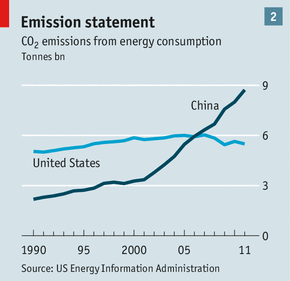
Despite a huge hydroelectric programme, most of this energy comes from burning coal on a vast scale. China currently burns about half the world’s supplies. In 2006 it surpassed America in carbon-dioxide emissions from energy (see chart 2). By 2014 or 2015 it will emit twice America’s total. Between 1990 and 2050 its cumulative emissions from energy will amount to some 500 billion tonnes—roughly the same as those of the whole world from the beginning of the industrial revolution to 1970. And the total is what matters. The climate reacts to the stock of carbon, not to annual rises.
These emissions are adding to a build-up of carbon already pushed to unprecedented heights by earlier industrialisations. When Britain began the process in the 18th century, the atmosphere’s carbon-dioxide level was 280 parts per million (ppm). When Japan was industrialising fastest in the late 1950s, it had risen a bit, to 315ppm. This year the level hit 400ppm. Avoiding dangerous climate change is widely taken to mean keeping below 450ppm, although there are significant uncertainties surrounding this figure. At current rates that threshold will be reached in 2037. China is likely to be the largest emitter between now and then.
About a quarter of China’s carbon emissions is produced making goods for export. If the carbon embodied in those goods were marked against the ledgers of the importing countries China would look a little less damaging, the rich world a lot less virtuous. But even allowing for that, China is not playing catch-up any more. It is doing more damage to the stability of the global climate than any other country.
Strange Tales from a Chinese Studio
China will suffer as much as anywhere. Already its deserts are spreading, farmland is drying out and crop yields are plateauing. Climate change may make matters worse. It has 80m people living at sea level who are vulnerable to rising oceans and higher storm surges. And as heavy manufacturing and mining move from coastal areas to poorer western provinces like Xinjiang and Tibet, the shift may increase environmental damage. These areas have particularly fragile ecosystems and degradation could quickly become irreversible.
Some of those problems may not become acute for a while. But the nation’s immediate environmental woes are already challenging the basic contract between rulers and people: rising living standards in exchange for acquiescence in the Communist Party’s monopoly of power.
The costs of environmental and natural-resource degradation, according to the World Bank, are the equivalent of 9% of GDP, an enormous amount which is dragging down the long-term growth rate. The biggest downdrafts include health damage from air pollution and the degradation of soil nutrients. And since the party takes credit for the benefits of growth, it gets blamed for the costs of pollution. As Ma Jun, China’s best-known environmental activist, puts it, “Everyone knows the link between the environment and their own health.” None of the challenges facing the new generation of leaders is bigger than those posed by the environment.
China is already doing a lot to meet that challenge, on paper at least. Even before the Beijing smog settled, the government had issued 20 significant anti-pollution laws and tens of thousands of decrees. It established a Ministry for Environmental Protection in 2008 and at the last Communist Party conference in 2012, added the environment to the four “platforms”—basic beliefs that define what the party stands for. In China, that sort of signal matters.
But the new leaders worry at least as much about faltering short-term growth as about environmental degradation. The prime minister, Li Keqiang, reflected these conflicting demands in his inaugural address in March, when he said: “It is no good having prosperity and wealth while the environment deteriorates,”—but then said it was just as bad to have “poverty and backwardness in the midst of clear waters and verdant mountains.”
In the West it is often said that one of China’s chief advantages in dealing with climate change is that its leaders can impose tough policies that democratic systems shy away from. Mr Wen once said the government would use “an iron hand” to make the country more energy-efficient. But in environmental matters the government does not have an iron hand.
If local officials—mayors and provincial or county party secretaries—do not like a policy, they can quietly ignore it. As an official in Guangdong once said about pollution controls, “We don’t think these decisions apply to us.” The bosses of large state-owned companies often wield as much power as the ministers who supervise them. Occult systems of patronage matter more than apparent hierarchies. In the Chinese system, the centre proposes; provinces and counties dispose.
The system is changing to reflect environmental concerns. Guizhou is one of the poorest parts of China. It also sits atop large reserves of coal. A few years ago it would have happily mined them. But in formulating a new development plan to catch up with the rest of the country, it is relying more on imported natural gas from Myanmar—partly to fulfil the various anti-pollution diktats from the centre.
But change is slow. One of the ways the centre can directly influence local officials is through the criteria used when judging who gets promoted. Until now the economy was the most important factor. Environmental considerations have been added over the years, albeit with fuzzy measurements. President Xi Jinping is trying to make greenery more important by saying officials will be held responsible for environmental problems in an area, even after they have been promoted out of it.
So far, though, tinkering with the promotion system has not worked. According to a study for America’s National Bureau of Economic Research, mayors who spent money on environmental projects (pollution-treatment plants and the like) in 2000-09 had a lower chance of promotion than those investing in infrastructure that boosted the economy, such as roads. Growth remains the main consideration locally and it is not yet clear that the centre can change this.
Dream of the Green Chamber
In the West public opinion put the environment on the map, forcing governments and firms to clean up. But it is not clear this will happen soon in China. True, the public is worried. Figures from CASS suggest a quarter of demonstrations are about the environment. They cannot be put down as easily as peasant protests: they are often middle-class, urban affairs which might one day become a nationwide movement. If China’s leaders want a reminder of why this prospect might matter, they need only look at the former Soviet Union. In all but one of the European countries that split away from the USSR, the political parties that formed the first governments began life as environmental movements.
But the government can downplay public pressure for the moment because the environment remains, it seems, a second-tier concern. According to Xinhua, China’s news agency, an opinion poll in February 2012 found that worries about food safety came third, after income inequality and soaring house prices. In March a poll in China Youth Daily, a party newspaper, also put food safety third, after corruption and income distribution; and in November 2012 China Daily said 52.6% of respondents set environmental degradation fourth on their list of anxieties, after the wealth gap, corruption and the power of vested interests.
Moreover, most environmental protests are local rather than national. Demonstrators complain about this city’s air or that city’s water, but not about China’s overall situation. Activists like Mr Ma concede that as a mass movement environmentalism is in its infancy.
The wider implication is that far from being good at solving environmental problems, the Chinese political system is no better than anyone else’s. The top is ambivalent, the middle sceptical and the grassroots weak and divided.
Given all that, the remarkable thing is not what China has failed to do but what it has achieved, especially in reining in carbon dioxide. Its carbon emissions are growing at half the rate of GDP, a bit better than the global average. China has also boosted investment in renewable energy far more than any other country. It has the world’s most ambitious plans for building new nuclear power stations.
To combine economic growth and environmental improvement, China has concentrated on reducing carbon intensity—emissions per unit of GDP (see chart 3). This fell by about 20% in the past five years and the government is aiming to cut it by 40-45% by 2020, compared with 2005. Most of the improvement is coming from a scheme to bully 1,000 state-owned enterprises (SOEs) into using energy more efficiently—arguably the single most important climate policy in the world.
The enterprises sign a contract with the central government agreeing to meet efficiency targets, abide by new building codes and install environmental-control equipment. This helped Chinese cement-makers (who produce as much of the stuff as the rest of the world put together) reduce the energy needed to make a tonne of cement by 30% in the ten years to 2009. The scheme has now been expanded to 10,000 SOEs, covering the majority of polluters.
China is also generating energy more efficiently. According to the World Bank, better operations and the closure of clapped-out plants helped to push the average thermal efficiency of its coal-fired power stations from 31% in 2000 to 37% in 2010; America’s remained flat, at 33%.
The other big energy change is China’s vast renewables programme. The government aims to get 20% of its energy from such sources by 2020, the same target as in richer Europe. The largest slice will come from hydropower, which accounted for around 15% of total energy in 2012 (with nuclear power at 2%). But the big rise comes from wind and solar: the government will roughly double investment in these two in 2011-16, compared with 2006-10. Chinese investment in renewables puts others to shame. It amounted to $67 billion in 2012, says REN21, a network of policymakers, more than three times what Germany spent. The aim is to have 100 gigawatts of wind capacity and 35 gigawatts of solar capacity by 2015.
Even by the standards of renewables, though, much of this is inefficient. China and America have almost the same windpower capacity but America gets 40% more energy from it. Chinese wind farms—classic creations of central planning—are often not plugged in or create power surges so big that the electricity grid cannot cope and they have to be unplugged again.
Dirty coal will remain China’s most important fuel for the foreseeable future (hopes of a shale-gas revolution may be constrained by water shortages). Coal is cheaper and, as Nat Bullard of Bloomberg New Energy Finance, a firm of market analysts, points out, it provides “baseload power”—continuous energy unaffected by a lack of sun or wind. Its cost advantages will shrink, though. China is the world’s lowest-cost producer of solar panels. Mr Bullard says solar power should become competitive without subsidies by 2020.
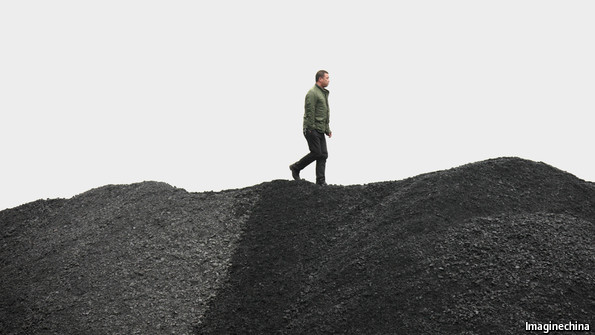 He can see the future and it’s black
He can see the future and it’s blackAs well as these supply-side measures, the government is also trying to reduce emissions by capping them and introducing a carbon price. The idea is unpopular in some quarters and is being introduced in stages—slipped in, as it were.
Along with reducing the targets it sets for energy intensity, China is setting up a pilot carbon-trading scheme in seven cities and provinces. Next, it plans to cap the amount of energy consumed, probably at 4 billion tce in 2015. That would require a sharp reduction in energy growth. The third stage is to turn the energy cap into a national emissions target. This is supposed to happen in 2016-20. The aim is to pave the way, in 2021-25, for provincial carbon budgets and a national carbon-trading system.
There is a lot of scepticism about whether this will happen as planned. But the basic aim—to rein in the rise of carbon emissions more quickly—may be met. A few years ago Chinese politicians said such emissions would go on rising at least until 2050. Now mainstream Chinese opinion says the peak will come in 2030-40. Academics at the Energy Research Institute and CASS reckon it could come earlier—in 2025-30. Compared with what seemed likely a few years ago, that would be a big achievement.
But compared with what China needs to do, it would not be enough. As a rough guide the world needs to restrict emissions to a little over 700 billion tonnes of carbon dioxide between now and 2050, if global temperatures are not to increase by more than 2°C above pre-industrial levels. The Stockholm Environment Institute calculates that, if China continues on its current path, it would emit almost two-thirds of that budget—roughly 450 billion tonnes— on its own. If it tries to live within its share of the global budget (which would be 220 billion tonnes, assuming countries’ shares of total emissions stay at current levels), then its emissions would have to fall to zero within ten years of a 2025 peak. This is inconceivable.
Call to Arms
The world appears destined to break that 700 billion tonne budget quite dramatically. How much of the overrun will be due to China? Over the next 20 years, it will build the equivalent of an America’s worth of new houses; the switch from rural to urban life roughly doubles energy use and carbon emissions per person. If China reaches the current living standards of industrial countries, the number of cars on its roads will rise tenfold.
Against that, and more importantly, the structure of the economy will change. Services account for 43% of GDP, a much lower proportion than in other middle-income countries. China can reasonably expect to increase the share of services, which are far less polluting, over the next 20 years.
Meanwhile, China could do even more to help itself. Its pricing of basic resources is skewed. Water and fertilisers in particular are too cheap, discouraging saving of its most precious resource. The country relies too much on command-and-control mechanisms and is hampered by bureaucratic complexity.
Yet China also has advantages in addressing its—and the world’s—environmental problems. Its leaders understand the challenge of climate change better than their predecessors and perhaps their international peers, too. They are good at taking action on high-priority issues. Because the country is a late developer, it should be able to learn from the mistakes of others—and not build energy-guzzling cities. China has a huge domestic market, cheap capital and sunny, windy deserts: the ideal environment to build a zero-carbon energy system. It is the silver lining of a very dark cloud. If China cannot do it, no one can.









